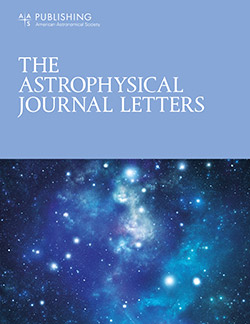热木星有巨大的伴星:共面高偏心率迁移的证据
IF 8.8
1区 物理与天体物理
Q1 ASTRONOMY & ASTROPHYSICS
引用次数: 0
摘要
本研究基于加州遗产调查行星目录的人口水平分析,考虑了具有巨行星的行星系统的特征。我们确定了热木星(HJs)的三个共同特征。首先,虽然不是所有的HJs都有一个被探测到的外行星伴星(msini = 0.3 - 30mjup),但当对40000天的轨道周期进行巡天完整性校正时,这样的伴星是无处不在的。没有HJ的巨行星庇护系统也至少有一个外部巨行星伴星。其次,HJs和其他巨行星的质量分布难以区分。然而,在一个包含HJ的行星系统中,外部的巨行星伴星至少比内部的HJ大3倍。第三,HJ系统外伴行星的偏心率分布(平均模型偏心率< e > = 0.34±0.05)与不含HJ的行星系统外伴行星的偏心率分布(< e > = 0.19±0.02)不同。我们得出结论,两颗气体巨星的存在是形成HJ的关键因素,其中最外层行星的离心率≥0.2,质量是HJ的3倍。我们基于这些因素的简单模型预测,约10%的温暖和寒冷木星系统将偶然满足这些组合标准,这与我们测量的HJ系统相对于所有巨行星系统的16%±6%的相对发生率是一致的。研究发现,这三个特征有利于共面高偏心运移成为HJ形成的主要机制。本文章由计算机程序翻译,如有差异,请以英文原文为准。
Hot Jupiters Have Giant Companions: Evidence for Coplanar High-eccentricity Migration
Abstract This study considers the characteristics of planetary systems with giant planets based on a population-level analysis of the California Legacy Survey planet catalog. We identified three characteristics common to hot Jupiters (HJs). First, while not all HJs have a detected outer giant planet companion ( M sin i = 0.3 – 30 M Jup ), such companions are ubiquitous when survey completeness corrections are applied for orbital periods out to 40,000 days. Giant-harboring systems without an HJ also host at least one outer giant planet companion per system. Second, the mass distributions of HJs and other giant planets are indistinguishable. However, within a planetary system that includes an HJ, the outer giant planet companions are at least 3× more massive than the inner HJs. Third, the eccentricity distribution of the outer companions in HJ systems (with an average model eccentricity of 〈 e 〉 = 0.34 ± 0.05) is different from the corresponding outer planets in planetary systems without HJs (〈 e 〉 = 0.19 ± 0.02). We conclude that the existence of two gas giants, where the outermost planet has an eccentricity ≥0.2 and is 3× more massive, are key factors in the production of an HJ. Our simple model based on these factors predicts that ∼10% of warm and cold Jupiter systems will by chance meet these assembly criteria, which is consistent with our measurement of a 16% ± 6% relative occurrence of HJ systems to all giant-harboring systems. We find that these three features favor coplanar high-eccentricity migration as the dominant mechanism for HJ formation.
求助全文
通过发布文献求助,成功后即可免费获取论文全文。
去求助
来源期刊

Astrophysical Journal Letters
ASTRONOMY & ASTROPHYSICS-
CiteScore
14.10
自引率
6.30%
发文量
513
审稿时长
2-3 weeks
期刊介绍:
The Astrophysical Journal Letters (ApJL) is widely regarded as the foremost journal for swiftly disseminating groundbreaking astronomical research. It focuses on concise reports that highlight pivotal advancements in the field of astrophysics. By prioritizing timeliness and the generation of immediate interest among researchers, ApJL showcases articles featuring novel discoveries and critical findings that have a profound effect on the scientific community. Moreover, ApJL ensures that published articles are comprehensive in their scope, presenting context that can be readily comprehensible to scientists who may not possess expertise in the specific disciplines covered.
 求助内容:
求助内容: 应助结果提醒方式:
应助结果提醒方式:


